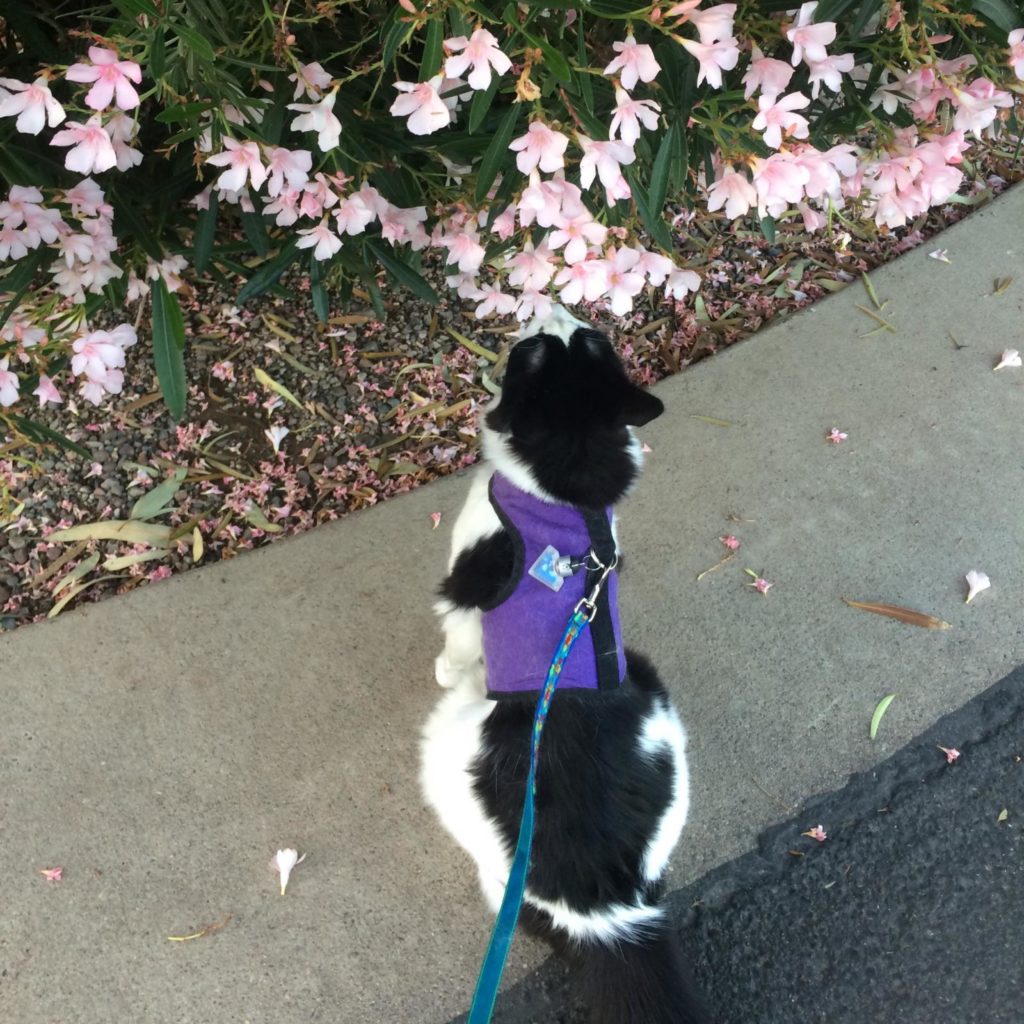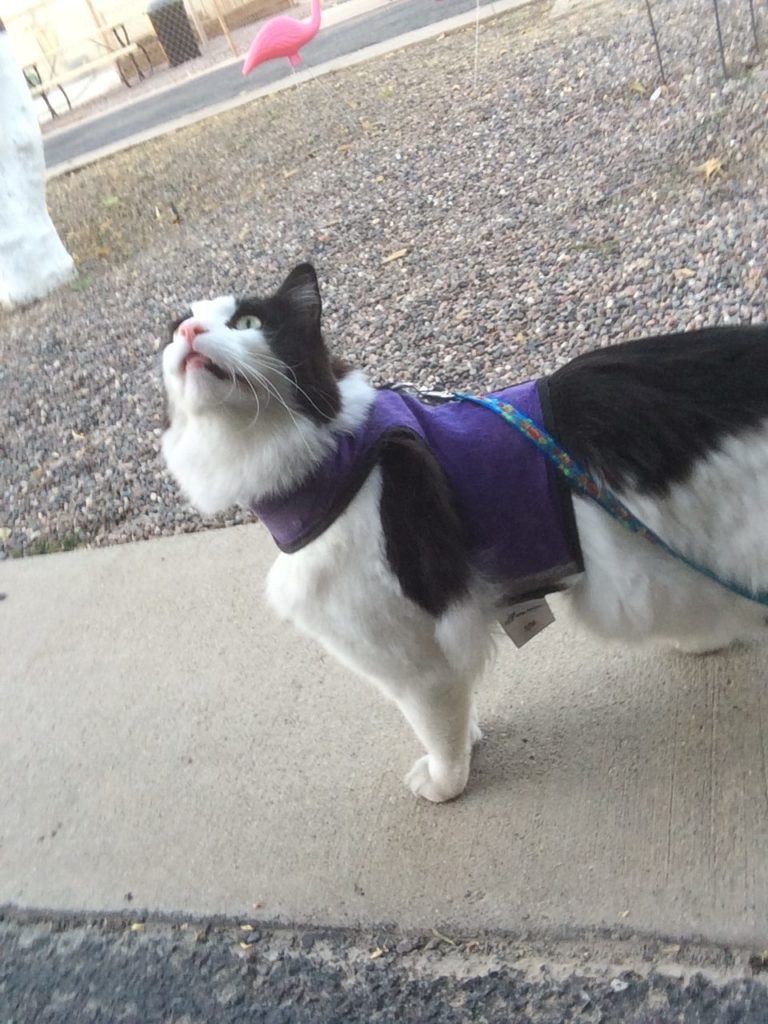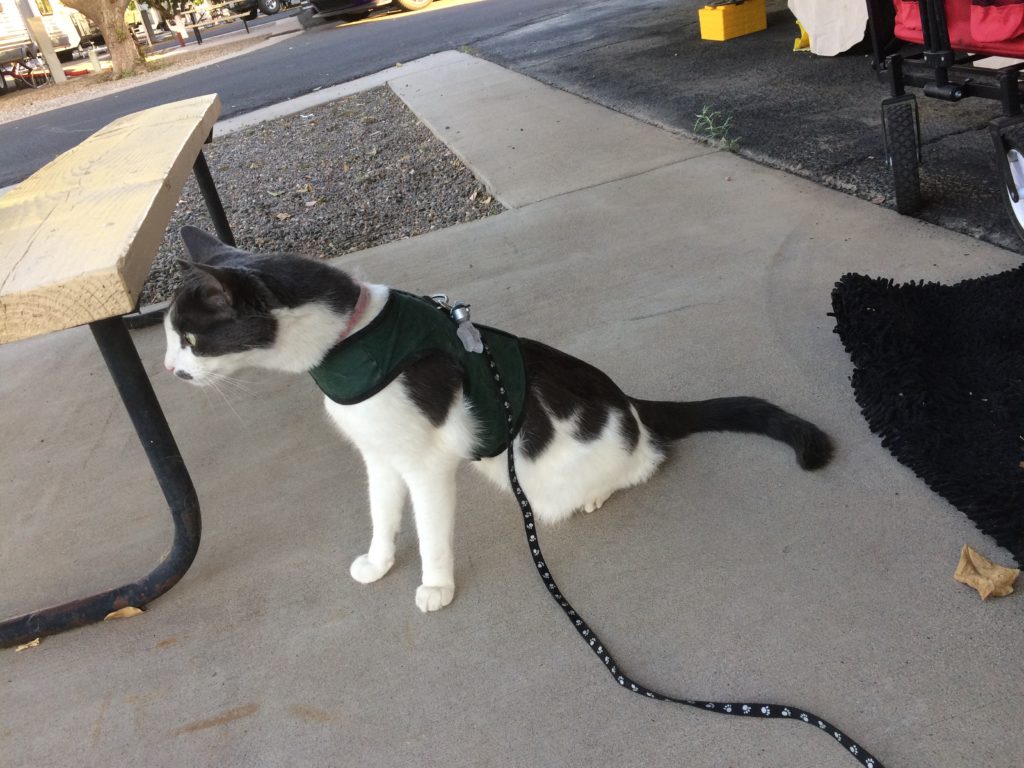
When we moved into our RV, we knew the cats would have a tougher time adjusting than we would. Their whole world (their indoor home) was squished down to less than 300 square feet, with all kinds of new smells and sounds. We’ve done a lot to “cattify” our RV, like adding scratching posts to the slide-out trim (blog posts forthcoming!) and low-profile cat condos handmade by David. But it’s not the same as being able to really stretch their legs and get some exercise.
When we were still living in a “sticks and bricks” house, we started practicing walking our cats using a Kitty Holster cat harness. We have four (yes, four!) cats, although at the time we had five, and the fifth was a professional traveler. Sadly we had to say goodbye to her about a year ago. Of the other four, two are little old ladies who would prefer to nap and watch the birds from the windows, one is a scaredy cat who WANTS to go out, but can’t bring himself to enjoy it yet, and our main handful is Tycho, an energetic ball of fluff who’s really taken a liking to the harness.

We’ve tried several harnesses over the years, and like the Kitty Holster best of all. It seems the most secure (hardest to escape), and the large surface area of the holster has a sort of calming effect on them (kind of like the Thundershirt, with less restriction and more movement). The Kitty Holster website has a ton of reviews, adorable pictures, and helpful information.
We started out by getting them used to the sound of the velcro of the harness. It’s a substantial amount of very secure velcro, so it’s kind of a scary noise for most cats. We also laid the harnesses flat on the floor, leaving treats on/around the harness, so they’d associate it with good things.
After a few days of this, we tried putting a harness on a cat, and taking it off almost instantly. More treats! And snuggles! And praise!
Every step of the process needs to be positive for the cat, or they may never like the idea of walking on a leash. And patience is key: if they seem overwhelmed or upset, put the harness away and try again later. You may even have to start from step one (not fearing the harness’s presence) if kitty’s just too stressed.
When you’re ready to go outside, think of a phrase you can use to signal to your cat that it’s time go out and when it’s time to go in. We kept it simple: “wanna go outside?” and “time to go in!” You may want to learn from our mistake and not use something as ordinary as “wanna go outside” because now whenever the humans wanna go outside, we have to rephrase it so Tycho doesn’t hear and go running to the door.
The first “outside” might only last a few seconds, or a minute. Their world has suddenly become ENORMOUS, and it can be very overwhelming with all the sights, smells, and sounds. Just say “time to go in!” and bring them back inside. You may have to carry them, but hopefully they’ll just walk right back in. Cue the treats! And snuggles! And praise!
Then try again tomorrow.
At some point, maybe a day, or a week, or a month, your kitty will let you lead (or expect you to follow their lead) a little ways. Go at your cat’s pace, and always end on a high note: always “time to go in!” before they get overstimulated.
Taking a cat for a walk definitely requires learning your cat’s body language: what does your cat’s ears and tail do when kitty’s content? stressed? excited? about to sprint away? Every cat communicates a little differently, but here are some cat communication basics to get you started.
Taking the time to walk your cat every day or a few times a week is a great way to keep them happy and exhausted so that they’re less likely to alleviate boredom indoors by destroying furniture or waking you up in the middle of the night.
That said, not every cat enjoys walking on a leash. If yours doesn’t, you might consider getting inexpensive indoor toys to help them work through their excess energy and exercise those hunting instincts. We love these Neko Flies Kattipede stick toys with replaceable/interchangeable bugs. They’ve been our longest lasting toys to date, but they also get great satisfaction from destroying a nice cheap feather on a stick. Cat toys were meant to be played with, so you should be proud when one is destroyed– just remember to discard the pieces so they don’t get hurt, and replace broken toys regularly.
